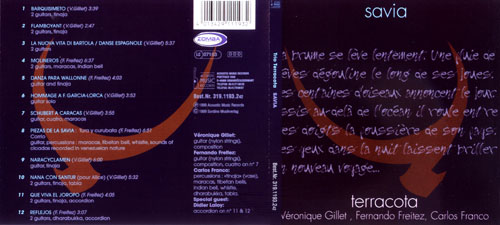01. Barquisimeto V.Gillet
02. Flamboyant V.Gillet
03. La nuova Vita di Bartola/danse espagnole V.Gillet
04. Molineros F. Freitez
05. Danza para wallone F. Freitez
06. Hommage à Garcia-Lorca V. Gillet
07. Schubert à Caracas V. Gillet
08. Piezas de la savia F. Freitez
09. Naracyclamen V. Gillet
10. Nana con santur V. Gillet
11. Que viva el joropo F. Freitez
12. Reflejos F. Freitez

ac.music.record. Germany 1999
Trio Terracota:
V. Gillet: guitar-compo, Fernando Freitez: guitar-compo, C. Franco: percussions,
special guest: Didier Laloy –accordéon on track 11, 12 Produced by Peter Finger
Label acoustic music n° 1193 germanyTwelve new compositions, entirely acoustic, where the human spirit is, once again, expressed
in a finaly honed harmonic language. The heart warming sonorities of resonating strings and
the “tinaja” (Barquisimeto, Flamboyant, Danza para wallone, Naracyclamen) evolve on their
way to new, sometimes strange, sound worlds: songs of cicadas from venezuelan desert
(Piezas de la savia), or emanating from Didier Laloy, special guest artist on the diatonic
accordion (Que viva el Joropo, Reflejos), or in an encounter with the cuatro (small 4 strings
carribean guitar) in Schubert à Caracas. A blink of a wink at Andalucia in the guitar duett:
Danse espagnole, and a meditative guitar solo Hommage à Garcia-Lorca. For the lullaby Nana
con Santur, the guitar carries us with an etherial sonority, that of the santur, an indian
cembalum. The maroccas take the solo on Schubert à Caracas, Molineros, Piezas de la
savia,and sprinkle with arid dust the damp soil of old Europ. A beautifull blend of two cultures.Ron Forbes-Roberts (Acoustic Guitar Central:reviews)USA :
“Trio Terracota, Savia There’s no shortage of two-guitar-and-percussion trios these days, but Trio
Terracota is a distinctive voice among the multitudes. Véronique Gillet and Fernando Freitez are
excellent guitarists whose technique and compositional sensibilities indicate considerable time spent
in classical studies. But while most of Savia’s 12 original pieces owe much to the classical tradition
—a few might even be described as neo–Spanish classical—they are all highly adventurous and
heavily influenced by ethnic and modern music.”